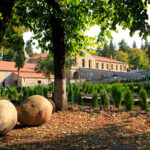
When many wine lovers think of Italy, their thoughts go immediately to Tuscany or Piedmont, even though wines from the Veneto are more present in the market. They have the characteristic Italian mix of expressive fruit, angular acidity and earthy minerality that make them a pleasure to drink and easy to pair with food. Like many areas within Italy, the Veneto, located in The Boot’s northeastern tip, between Trentino-Alto Adige to the west and Friuli-Venezia Giulia to the west, is a wine region on the rise.
 The recent history of the wine production in the Veneto has been typical of a dynamic that has played out in many regions across Italy. In short, since the 1950s, many producers across Italy have gone from a factory mentality to one focused on quality and terroir. By volume, Italy is the largest wine-producing country in the world and, for many years, Italy’s leading region has been the Veneto, well ahead of Puglia and Emilia Romagna, respectively. Like many volume wine-producing regions in Europe, the Veneto makes a lot of commercial wines, however, wines that were strictly known as big company brand names a generation ago have evolved into serious fine wines in today’s market. Whether it’s a dry, floral, elegantly mineral Soave; a light, crisp, fresh, red berry Bardolino; a chewy, delightfully rustic, plum-filled Valpolicella; or a Prosecco from Conegliano Valdobbiadene, with toasted bread and tangy, dried stone fruit notes; what had been known for decades only as anonymous, bulk wines have emerged as honest examples of high-quality wines that show a sense of place.
The recent history of the wine production in the Veneto has been typical of a dynamic that has played out in many regions across Italy. In short, since the 1950s, many producers across Italy have gone from a factory mentality to one focused on quality and terroir. By volume, Italy is the largest wine-producing country in the world and, for many years, Italy’s leading region has been the Veneto, well ahead of Puglia and Emilia Romagna, respectively. Like many volume wine-producing regions in Europe, the Veneto makes a lot of commercial wines, however, wines that were strictly known as big company brand names a generation ago have evolved into serious fine wines in today’s market. Whether it’s a dry, floral, elegantly mineral Soave; a light, crisp, fresh, red berry Bardolino; a chewy, delightfully rustic, plum-filled Valpolicella; or a Prosecco from Conegliano Valdobbiadene, with toasted bread and tangy, dried stone fruit notes; what had been known for decades only as anonymous, bulk wines have emerged as honest examples of high-quality wines that show a sense of place.
By far, the fine wine that has carried the reputation of the Veneto around the world is Amarone della Valpolicella. The Valpolicella appellation is located in the western end of the Veneto. Within this zone, the Amarone della Valpolicella DOCG (Denominazione di Origine Controllata e Garantita) includes the subzones of Valpantena and Classico, the historic areas of production comprised of the Fumane, Marano, Negrar, San Pietro in Cariano, and Sant’Ambrogio communes. Formerly part of the Valpolicella DOC, Amarone della Valpolicella was established as a separate DOCG in 2010.

By itself, the term ‘Amarone’ describes a style of wine and comes from the word ‘amaro’ (bitter), an attractive character special to the aroma and flavor profile of these wines. Amarone della Valpolicella is a blended wine. Most are made from Corvina and Rondinella, sometimes including a percentage of Molinara and Corvinone, all indigenous grapes to the Veneto. Amarone della Valpolicella is made using the appassimento method, where grapes partially dried on racks in open-air sheds are mixed with just-picked fruit during fermentation. It’s the concentrated sugar in the semi-dried grapes that contributes a marked richness and density, giving Amarone della Valpolicella its distinctive full-bodied weight and heft on the palate. Made in a similar way, Recioto della Valpolicella wines have relatively high sugar levels while Amarone della Valpolicella is fermented to dryness. Amarone della Valpolicella wines have a ripe, rich aroma and flavor profile, but the solid extract and structure of these wines makes them dry, not sweet as is the common misconception. In general, winemakers contend that it is extremely difficult to make a burly, bold character wine at 15% alcohol or higher that shows elegance and balance rather than overt heat. The best examples of Amarone della Valpolicella accomplish this feat, which is vinous magic.
Producers to look for are Bertani, which makes beautifully “old school,” traditional wines, Le Ragose, Masi, Tedeschi, Marion, and Tommaso Bussola. Giuseppe Quintarelli and Romano Dal Forno are legendary estates that make tiny quantities of incredible wines with stupefying prices.
The Veneto has continued a healthy evolution to produce wines that belie old expectations, wines whose quality prompts us to re-examine and re-think this region and wines based on its native grapes.


